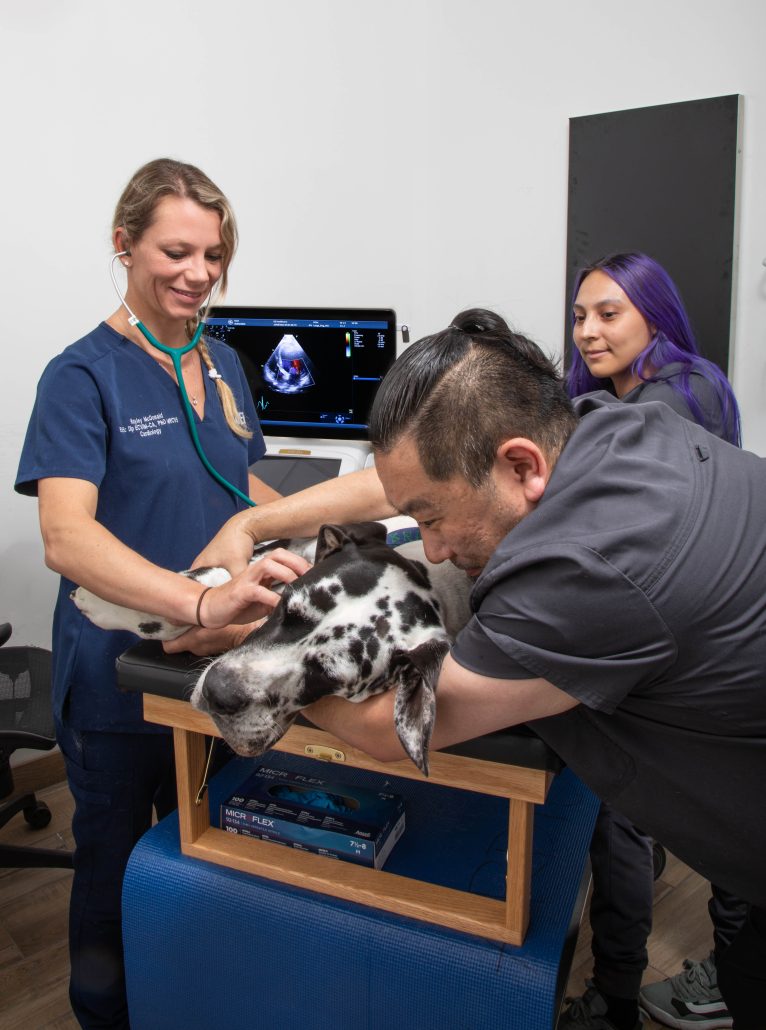What You Required to Understand About Vet Services: An Overview of Diagnostic Devices and Procedures
Veterinary solutions play a crucial role in preserving the health and wellness of pets. Routine check-ups can expose covert health problems at an early stage. Different diagnostic devices and procedures, such as blood examinations and imaging methods, supply vital insights right into an animal's health. Recognizing these methods is vital for animal owners. What details diagnostic treatments are most typically utilized, and just how can they affect a pet's treatment strategy?
Significance of Regular Veterinary Exams
While many pet dog owners might ignore the value of regular vet check-ups, these consultations are important for keeping a pet's general wellness. Routine check outs to the vet enable for very early discovery of potential health issues before they rise right into serious troubles. Regular examinations usually include inoculations, which are essential for stopping transmittable conditions that could seriously affect a pet dog's health. In addition, these appointments supply a possibility for vets to analyze the animal's weight, oral wellness, and total problem, guaranteeing that the pet dog is growing. Throughout these check outs, animal owners can additionally obtain beneficial advice on diet, exercise, and preventive care tailored to their specific family pet's requirements.
Typical Diagnostic Procedures in Vet Medicine
In veterinary medication, precise medical diagnosis is essential for effective therapy. Usual analysis treatments consist of blood testing techniques, progressed imaging modern technologies, and urinalysis, each playing a significant duty in identifying health issues. Understanding these approaches improves the capacity to supply proper look after animal individuals.
Blood Checking Methods
Blood testing strategies act as vital diagnostic devices in veterinary medicine, allowing veterinarians to assess the health and wellness of animals accurately. These techniques include collecting blood examples to examine different parts, such as white and red blood cells, platelets, and biochemical markers. Typical tests consist of complete blood matters (CBC), which review total health and wellness and spot infections, and biochemical panels, which analyze body organ feature and metabolic status. In addition, serological tests can recognize details illness via antibody detection. Blood screening is minimally intrusive and supplies important details that aids in identifying conditions, keeping track of wellness status, and examining actions to treatments. Generally, these techniques play a crucial function in making certain optimal care for pets and animals alike.
Imaging Technologies Used
Diagnostic imaging modern technologies are essential devices in veterinary medicine, matching blood screening methods by supplying aesthetic insights right into an animal's interior frameworks. Usual imaging methods include X-rays, which are beneficial for evaluating bone fractures and finding international things, and ultrasound, which permits real-time visualization of soft tissues and organs. Magnetic resonance imaging (MRI) supplies comprehensive photos of complicated anatomical areas, particularly in neurological assessments. Calculated tomography (CT) gives cross-sectional photos, boosting analysis precision for numerous problems. Each of these technologies help vets in diagnosing illnesses, planning treatments, and checking recovery. By incorporating imaging technologies, vet specialists can better examine a pet's health and wellness and make notified choices regarding their treatment.
Urinalysis and Diagnostics
Urinalysis acts as an essential analysis tool in veterinary medication, giving useful insights into an animal's total health and wellness and helping in the detection of various problems. This non-invasive treatment evaluates pee examples to evaluate kidney function, hydration standing, and metabolic conditions. Common parts taken a look at include certain gravity, pH levels, glucose, proteins, and the visibility of blood or germs. Abnormal searchings for can suggest issues such as urinary system tract infections, diabetic issues mellitus, or kidney disease. To boost diagnostic precision, urinalysis is commonly performed in conjunction with various other tests, such as blood job and imaging studies. Early discovery with urinalysis can lead to prompt interventions, enhancing the prognosis for several veterinary people. For that reason, it is a vital aspect of detailed veterinary treatment.
Understanding Blood Examinations and Lab Evaluation
Understanding blood tests and lab analysis is essential in veterinary medicine as it aids in detecting various health and wellness problems in animals. Different sorts of blood examinations offer crucial details concerning a pet's internal state, while analyzing laboratory results requires cautious consideration of various variables. This area will check out the kinds of blood tests available and the relevance of their outcomes.
Sorts Of Blood Examinations
Blood examinations play an important duty in veterinary medication, giving essential insights right into a pet's health status. Various sorts of blood examinations are made use of, each offering different functions. Full blood counts (CBC) assess overall health and discover problems such as anemia or infection. Biochemical accounts evaluate body organ feature by gauging enzymes and electrolytes, using understandings into metabolic health and wellness. Serological examinations recognize details antibodies or virus, assisting in the diagnosis of infections or autoimmune illness. Blood typing guarantees safe transfusions, while coagulation tests gauge the blood's ability to clot, vital for medical treatments. These examinations jointly boost diagnosis, treatment planning, and monitoring of an animal's wellness, showing the value of comprehensive laboratory evaluation in vet care.

Translating Lab Results
A complete evaluation of lab results is crucial for exact diagnosis and therapy in vet medication. Interpreting laboratory results calls for an understanding of normal recommendation varieties and the importance of discrepancies. Blood tests can expose numerous health indicators, such as organ function, electrolyte equilibrium, and the visibility of infections. Vets must think about the whole professional picture, including the animal's history, health examination searchings for, and any signs find out here now offered. Variants in results might arise from elements such as age, breed, and underlying wellness conditions. Lab results should not be seen in isolation but instead as component of an all-encompassing diagnostic approach. Exact analysis permits customized therapy plans and much better outcomes for veterinary patients.
Imaging Techniques: X-rays, Ultrasounds, and Beyond
Imaging techniques are vital tools in vet medication, offering crucial insights right into the wellness and health of animals. Among one of the most generally made use of approaches are Ultrasounds and x-rays. X-rays are indispensable for imagining bone structures, helping vets determine fractures, lumps, or foreign objects. This method is non-invasive and quick, making it ideal for immediate situations.Ultrasounds, on the various other hand, utilize acoustic waves to produce pictures of soft cells and organs. This strategy is especially useful for examining the heart, abdominal area, and reproductive organs, permitting veterinarians to assess problems like fluid build-up or organ abnormalities.Beyond X-rays and ultrasounds, progressed imaging techniques such as computed tomography (CT) and magnetic vibration imaging (MRI) are progressively utilized in vet technique. These techniques supply thorough cross-sectional images, improving the accuracy of diagnoses and therapy plans. Ultrasound For Dogs. In general, imaging strategies play a vital function in ensuring efficient vet treatment
The Duty of Biopsies in Diagnosing Animal Health Issues
Accuracy in detecting health problems in pets typically rests on the use of biopsies, which supply clear-cut information about cells problems. A biopsy involves the removal of a small sample of tissue for assessment under a microscopic lense, permitting veterinarians to recognize various conditions, including infections, growths, and inflammatory conditions. This diagnostic tool is necessary for identifying between benign and malignant developments, leading treatment choices, and assessing the extent of a condition.Biopsies can be performed using various techniques, such as needle goal, incisional biopsies, or excisional biopsies, relying on the area and kind of cells entailed. The selection of method may affect recuperation time and the quantity of cells collected. Ultimately, the information amassed from a biopsy can bring about targeted therapies, improving outcomes for pets facing serious health and wellness difficulties. Veterinarians emphasize the importance of this procedure in attaining precise diagnoses and effective therapy plans.
Advanced Diagnostic Equipment: Endoscopy and CT Scans

Advanced diagnostic devices, such as endoscopy and CT scans, play a crucial duty in modern veterinary medication, using non-invasive techniques to visualize inner structures and identify various conditions in family pets. Endoscopy entails using a flexible tube equipped with a cam, allowing vets to analyze the gastrointestinal tract and breathing system directly. This strategy can reveal irregularities such as tumors, international bodies, or swelling, allowing targeted therapy plans.CT scans, on the various other hand, utilize innovative imaging technology to produce thorough cross-sectional pictures of the body (Ultrasound For Dogs). This technique is specifically useful for examining facility frameworks like the mind, spine, and joints. By giving high-resolution photos, CT scans help veterinarians in identifying problems that might not be noticeable through standard radiography. With each other, these innovative tools enhance diagnostic precision, boost therapy outcomes, and ultimately add to far better total pet health administration

Interpreting Examination Outcomes: What Animal Owners Need To Know
Comprehending test outcomes can be a tough task for family pet proprietors, particularly after sophisticated treatments i was reading this like endoscopy and CT scans have been executed. Translating these outcomes calls for an understanding of clinical terminology and a clear understanding of what the searchings for suggest concerning the animal's health and wellness. Vets frequently supply descriptions, but the intricacy of the results can still cause confusion.Pet proprietors should proactively participate in discussions with their vets, asking questions to clarify any kind of uncertainties. It is necessary to understand typical versus abnormal results and the ramifications for the pet dog's treatment plan. Furthermore, identifying that some outcomes may require additional screening or surveillance can help owners stay notified concerning their pet's health and wellness journey. Inevitably, a collective method between family pet proprietors and vet specialists fosters much better health and wellness end results and boosts the general treatment experience for pets.
Frequently Asked Concerns
Exactly how Do I Select the Right Veterinary Center for My Animal?
Selecting the ideal vet clinic entails looking into local alternatives, evaluating certifications, seeing facilities, and examining team communications (Ultrasound For Dogs). Focusing on referrals from relied on resources can assist ensure the finest treatment and environment for a pet's health demands
What Should I Do if My Pet Dog Declines to visit the Vet?
When an animal refuses to go to the veterinarian, it's recommended to stay calm, usage deals with or toys to best site tempt them, and take into consideration setting up a home see if stress and anxiety continues. Perseverance and favorable reinforcement are key.
Exist Telehealth Options for Vet Services?
Telehealth alternatives for veterinary services are significantly available, enabling family pet owners to speak with vets from another location. These solutions make it possible for conversations concerning wellness worries, suggestions on small disorders, and follow-ups without requiring to see a clinic.
Exactly how Typically Should My Pet Have Dental Check-Ups?
The frequency of dental exams for family pets typically depends on their age and type. Usually, veterinarians advise annual dental evaluations, although some pets might call for more regular check outs to maintain ideal dental health.

What Are the Prices Related To Vet Diagnostics?
The costs related to veterinary diagnostics can differ widely, normally ranging from standard tests like blood work to sophisticated imaging strategies. Variables influencing costs consist of the clinic's location, devices made use of, and specific examinations needed for each pet. Vet solutions play an essential role in keeping the health of pet dogs. While numerous family pet proprietors might underestimate the importance of normal veterinary examinations, these visits are crucial for maintaining a pet's total health. Additionally, these appointments offer a possibility for veterinarians to evaluate the animal's weight, dental health and wellness, and general condition, guaranteeing that the animal is flourishing. Precision in identifying health and wellness issues in animals typically hinges on the use of biopsies, which offer conclusive info about cells irregularities. Furthermore, identifying that some outcomes might need additional testing or monitoring can assist proprietors stay informed concerning their pet dog's health journey.